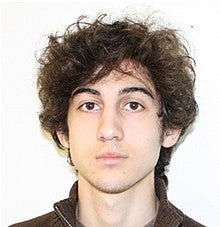This weekend our suggestion is something that hits close to home — at least for your narrator: the Netflix three-part series, “American Manhunt: The Boston Marathon Bombing.”
(the younger of the bomber brothers, Dzhokar Tsarnaev) (wikipedia)
(Tamerlan Tsarnaev. Source: wikipedia)
Released just in time for the tenth anniversary of the bombing (the Boston marathon is scheduled for Monday), the show takes you inside the intense investigation of what at the time was the worst terrorist attack the nation had seen since 9-11. That it happened over the course of four days of high drama only makes the series that much more compelling.
One of the dynamics in the show is the tension between the Boston Police Department — led by Commissioner Ed Davis, who is prominently featured here — and the FBI. I can tell you that, if anything, the series underplays that tension.
While the show dwells a bit on the disagreement between the two agencies as to whether the photos of the (at the time unidentified) Tsarnaev brothers should be released, the real underlying dispute is whether the Tsarnaevs were lone-wolf actors. Commissioner Davis feels strongly that the pressure-cooker bombs were too sophisticated to have been made by two mopes using internet instructions; the FBI disagrees.
Your narrator spent over half his career working terrorism. On this one, I am with Commissioner Davis (full disclosure: I met him, professionally, several times over the years. A gracious man).
There was in fact a point after the bombings — portrayed in episode two of the show — at which the brothers were planning to travel to New York, replete with a car full of bombs. Thanks to the heroic escape of a hostage, that intel was conveyed to us in New York. Suffice to say, the succeeding days at work were… interesting.
Having had some insight into the case, I believe there are several major questions that remain outstanding:
The Marathon bombings occurred in 2013. But Tamerlan Tsarnaev was apparently on the FBI radar as early as at least 2011. He had been interviewed by the FBI regarding the murder of two Jewish marijuana dealers and their friend (significantly, the murders occurred on September 11, 2011 — the tenth anniversary of the 9/11 attacks).
Tamerlan apparently committed the murders with a fellow Chechen named Ibragim Todashev. During an interview with the FBI after the Marathon bombings, Todashev reportedly attacked the agents and was shot dead.
Was Todashev part of the Boston bombing plot? And why was the FBI interested in a state-level murder case in 2011?
A possible answer is that Russian intelligence had actually tipped the FBI to Tamerlan’s jihadi interests in 2011. The feds subsequently put Tamerlan on a terrorist watchlist.
But when, in 2012, Tamerlan traveled to Dagestan (where his interest in jihadism intensified), he was then allowed to re-enter the U.S. How was that possible for a watch-listed non-citizen?
And finally, there’s this — a question that has bothered me for ten years: There were several days after the bombings during which the photos of the unidentified bombers were plastered everywhere. My team was scouring websites and running facial-recognition software around the clock — with no luck.
Now, Tamerlan was a striking, hulking figure standing over 6-foot tall. A guy you’d remember talking to. Especially in the context of a triple murder.
How is it possible that the agents who interviewed him in 2011 regarding the triple murders didn’t recognize him a year-and-a-half later, when the photos of the “unidentified” Marathon bombers were released?
Wherever the answers lie, what is clear is that the investigating team of cops and feds worked themselves half-to-death trying to solve the case (the show relates that some of the investigators actually collapsed from exhaustion and had to be hospitalized).
For all the questions and tensions, they did a great job, handling a type of case no one had before encountered.
(Dzhokar Tarsanev, currently on death row. Source: wikipedia)
The other stars here are the people of Boston, who pulled together and supported both the investigators and each other. (And I say that as a hater of all Boston sports teams).
The series is not only high-drama-well-told, but a worthy reminder of what the Age of Terror was like before we decided to put it in the rearview mirror. Watching this series, all I could think was: Let’s hope it stays there.
(Oh — and hang in for the last episode, where a few gratuitous shots are taken at — of course! — Fox News. The quick clip of The Five alone is a mini-time machine, worth the wait!).





